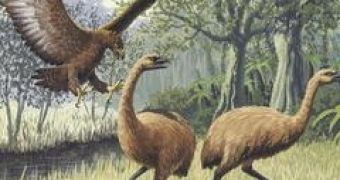The giant moa birds were exterminated within 200 years of human settlement of New Zealand by Maori people.
But DNA from old bones helps us now to recover the mysteries of these creatures.
For long, the number of moa species has been overestimated.
The DNA analysis showed the smaller specimens to be the males of the same species. Based on bones 8000 years old, the analysis proved the largest females to be 1.5 times higher and 2.8 times heavier than largest males.
The gender size dimorphism seems to be the biggest of any avian or mammalian species so far.
The giant moa were all females, weighing 76 to 242 kg and being 1.2 to 1.9 m tall at the back. Males, formerly thought to be a distinct species, weighed only 34 to 85 kg, and were 0.9 to 1.2 m tall at the back.
Both the Lambert-Millar group and the other group, led by Oxford-based expatriate New Zealander Dr Alan Cooper, found that females accounted for most of the moa bones that have been preserved in swamps and deposited in museums.
"That suggests the females were out foraging and maybe the males were sitting on the eggs, as the male kiwi do," said Professor Lambert.
Dr Cooper's group suggested that the big females were needed to produce big eggs for their young to survive in the forests.
DNA analysis revealed also a second turkey sized species. In this species, the sexual dimorphism was not so marked.
This DNA analysis was the first to be done to an extinct species.
Similar studies could break through further, in determining traits like color or diet.
More than $800,000 will be spent on a study of North Canterbury moa fossils. The goal is to see whether the birds were in decline before Maori began hunting them to extinction.
DNA study will demonstrate whether the moa population before human settlement was stable.
Before Maori arrived, the only predators of moa were powerful Haast eagles.
The eagles could kill the moa with a single strike to the head or neck, but vanished within a few centuries of Maori arriving because of eradication of their stable food supply by Maori hunters.
A team led by Dr Holdaway, of Palaecol Research Ltd, will try to discover the diet of moa, their changing diet with the age, social organization, species, sex, through DNA analysis.
Radiocarbon dating will be used to try to determine the ages of some bones at two major deposits in North Canterbury.
Stable isotope analysis will provide insights into what the birds ate, and from what area.
Two deposits of moa bones were found at the Pyramid Valley swamp in 1939 and 65 years later, 5km away, beneath Bell Hill Vineyard.
The swamps trapped birds of all ages from a period extending back 4000 years.

 14 DAY TRIAL //
14 DAY TRIAL //